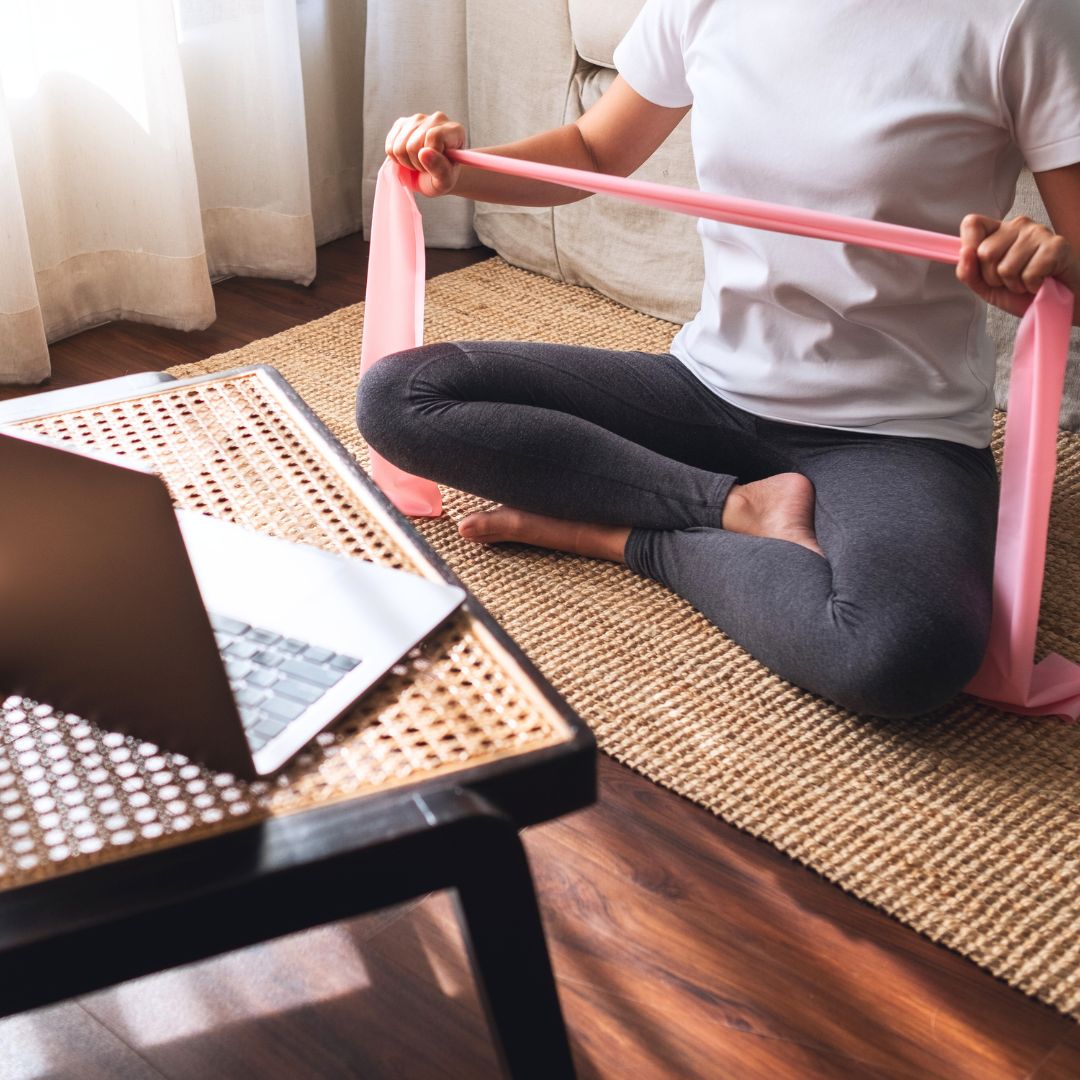
It’s easy to modify the intensity of a Pilates workout when you’re in a studio, working out under the watchful and enthusiastic eye of an instructor. But, when you’re getting your reps in at home or on-the-go, without access to a variety of equipment, it can be tricky to increase the difficulty. If you’re looking for a simple way to make your solo Pilates sessions more challenging and build strength in the process, you may want to introduce some of the best Pilates band exercises into your routine.
Pilates, you’ll know, has been trending tirelessly throughout 2024. At the start of the year, PureGym’s UK Fitness Report forecasted that three different types of Pilates – wall, mat and Reformer – would remain among the top 20 fitness trends all year long, and wasn’t that prediction on point? At the time of writing, there are no less than 218.1 million videos of "Pilates workouts" on TikTok. The exercise has well and truly dominated – and for good reason.
Research published in the Muscle, Ligaments and Tendons journal suggests that the benefits of Pilates may span improved flexibility, abdominal and lumbopelvic stability, and muscular activity. It’s also a low-impact activity that’s gentle on the joints and is therefore widely accessible.
That said, between busy schedules and the ever-increasing cost of everyday essentials, studio-based Pilates sessions may not always be within reach. But, that’s not to say you can’t have an effective workout at home – and incorporating some of the best Pilates bands into your training may help.
Here, Core LDN founder Claire Mills explains exactly how introducing resistance bands into your Pilates workouts can be beneficial, and shares six exercises to get you started. For more handy home workouts, scroll our guides to the best Pilates exercises for beginners, best Pilates core moves, best core sculpting Pilates moves and the best Pilates bar exercises.
On the hunt for the best Pilates band exercises? A top coach shares her take
What are resistance bands used for in Pilates?
There are a few reasons resistance bands are utilised in Pilates. They’re used to add resistance to exercises, which increases the challenge and can support your progress. Pilates bands are also used for rehabilitation when someone is pre- or post-natal or returning from injury. “Resistance bands are great for closed-chain exercises. This means that the exercise involves multiple joints and muscles working together,” explains Mills. “Closed chain exercises help create force, and are therefore great for facilitating strength and giving feedback in exercises."
Resistance bands are also used to mimic reformer Pilates moves. “On the reformer, the spring resistance is creating progressive tension in the muscle,” says Mills. “The resistance makes muscles work through the three phases of contraction – concentric, eccentric and isometric. Using a resistance band will allow you to achieve this same type of muscle work. Resistance bands create resistance to pull against or push into creating these similar effects to the spring resistance on the reformer.”
@soderlindjennie ♬ Fortnight by Taylor Swift - Music Society 🎶
Are Pilates bands effective?
Resistance band exercises aren’t exclusive to Pilates – they’re utilised in various forms for the simple reason that they’re effective and convenient.
Research from 2019, for example, indicated that exercising with elastic devices (such as resistance bands) provides similar improvements in strength when compared to resistance training performed with weight machines and dumbbells. The main benefit? Pilates bands are easily portable, require next to no storage space at home, and cost very little to buy.
“Resistance bands can mix up your workouts by introducing different muscle work and challenges to your Pilates,” says Mills. “They can therefore progress and regress exercises, allowing you to work more on strengthening muscles. Resistance bands also allow you to joints and muscles in a low-impact way, minimising stress on joints while having the strengthening benefits.”
Can you build strength and muscle with Pilates bands?
If your main goal is to build strength, you’ll find weight training more effective and efficient than Pilates band exercises. A Heliyon study, which weighed up whether pilates is better than other exercises for building strength, concluded that although pilates can be helpful for increasing muscle strength when compared to no activity, the increase is not greater than compared with other types of exercise, such as weight lifting. Basically, if you want to increase your muscle mass and build more strength, it’s best to prioritise a weight training programme based upon the principle of progressive overload (where the level of difficulty is gradually increased over time to continually challenge muscles).
That said, research confirms Pilates can be beneficial for building strength. A 2022 study found that Pilates may be beneficial for increasing muscle strength and improving balance when compared to no activity whatsoever. “If you want to build strength, you need to make sure you’re using abands with an optimal level of resistance, along with appropriate rep and set ranges,” Mills explains. “Generally, Pilates works on endurance muscle strength as it is a lower intensity, higher rep type of exercise.” It’s important to factor in progressive overload if you’re working towards increased strength via the best Pilates band exercises. This would involve gradually increasing the intensity, duration, reps, sets, or resistance of your workouts so you’re constantly challenging your muscles.
@kailawenn ♬ Dance You Outta My Head - Cat Janice
6 of the best Pilates band exercises, according to an instructor
1. Band-assisted crunches
What? Band-assisted crunches.
Why? "Band-assisted crunches (5:56 minutes into video) are a great core and abdominal exercise," says Mills. "The resistance created by pressing the band on the shins and pulling hands down by your sides will challenge core control, and mimics reformer exercises."
2. Four point kneeling press
What? Four point kneeling press.
Why? "I love adding resistance bands into the four-point kneeling exercises (6:35), an already challenging position, to ramp up the difficulty," says Mills. "The band helps give feedback to the muscle while also challenging core control and adding extra glute work."
3. Band-assisted abs exercise
What? Band-assisted abs exercise.
Why? "This (9:57) is a guaranteed ab burner," Mills says. "I love how this exercise challenges your hip flexor control alongside your lower abs, working short on one side and long through the other creating a real core challenge. To make it easier, you would put the band around your thighs."
4. Resistance band roll-ups
What? Resistance band roll-ups.
Why? "This exercise (10:39), using a resistance band, helps support the mobility of the spine and control the abdominal work," explains Mills. "I give this exercise to anyone who is unable to do a full roll-up, or who is rehabbing a back injury and introducing loaded flexion back into their Pilates exercises. The stronger the band, the more support you have."
5. Static lunge with tricep exercise
What? Static lunge with tricep exercise.
Why? "This is a whole-body exercise (7:47) that targets your glutes, core and upper body," says Mills. "It also mimics standing reformer work."
6. Band-assisted skater/scooter exercise
What? Band-assisted skater/scooter exercise.
Why? "This exercise (26:10) is my go-to for challenging hip and pelvic strength, and targeting both the stabilising and moving leg," says Mills.
Shop MC UK's go-to Pilates kit:
This set comes with three different band strengths, so you can make each exercise easier or more challenging depending on which one you choose.







